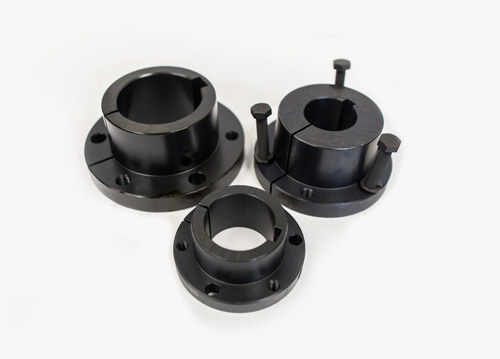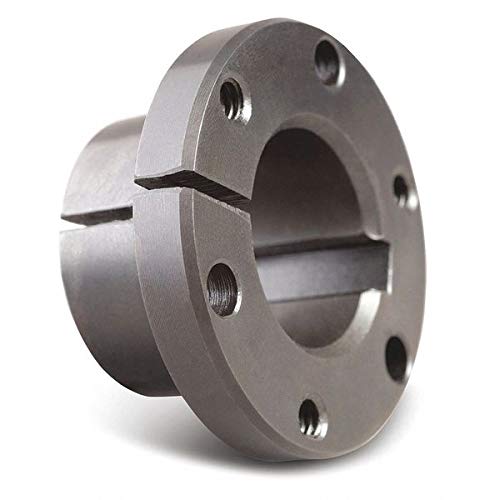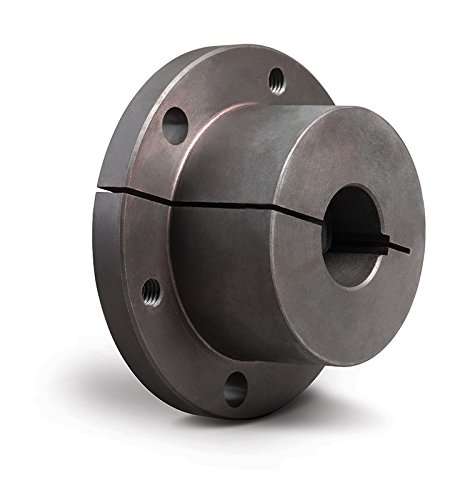Product Description
| Product Name | Taper Bush | Model | 1008-5050,6050-12100 |
| Brand | Mighty | Material | Cast Iron GG22-GG25,Steel C45 |
| Surface treatment | Blank/phosphated/black | QD Bushing model | H/JA/SH/SDS/SD/SK/SF/E/F/J/M/N/P/W/S, orG/H/P1/P2/P3/B/Q1/Q2/Q3/R1/R2/S1/S2/U0/U1/U2/W1/W2/Y0 |
Feature:
1. The simple design allows for easy maintenance, it is a simple easy-on, easy-off process.
2. Machined to high precise tolerance
3. A full range of both metric and imperial sizes taper bushes are available
4. Complete short reach range available, for compact lightweight assemblies
Taper Bush
1.Model: 1008-5050,6050-12100
2.Material: High grade cast iron GG22-GG25;Steel C45
3.Surface treatment: Blank/phosphated/black finished
QD Bushing
1.Model:H/JA/SH/SDS/SD/SK/SF/E/F/J/M/N/P/W/S,orG/H/P1/P2/P3/B/Q1/Q2/Q3/R1/R2/S1/S2/U0/U1/U2/W1/W2/Y0
2.Material: Cast iron GG25/steel;
3.Surface treatment: Blank/phosphated/black finished
| Standard or Nonstandard: | Standard and Customized |
|---|---|
| Feature: | Taper Bore |
| Application: | Taper Bore Locking |
| Surface Treatment: | Baking Paint |
| Material: | Steel, Cast Iron |
| Color: | Customizable |
| Samples: |
US$ 0.1/Piece
1 Piece(Min.Order) | |
|---|
| Customization: |
Available
| Customized Request |
|---|
What are the temperature and environmental considerations when using QD bushings?
When using QD (Quick Disconnect) bushings, it is important to take into account temperature and environmental factors to ensure their optimal performance and longevity. Here are some key considerations regarding temperature and environmental conditions:
- Temperature Range: QD bushings are typically designed to operate within specific temperature ranges. It is crucial to understand the temperature limits specified by the manufacturer for the particular type and material of the bushing. Exceeding these temperature limits can lead to premature wear, reduced load capacity, dimensional changes, or even failure of the bushing. Extreme heat or cold can affect the material properties, lubrication, and overall functionality of the bushing.
- Operating Environment: The operating environment plays a significant role in determining the performance and durability of QD bushings. Factors such as moisture, humidity, dust, chemicals, and corrosive substances can impact the bushing’s performance and lifespan. In corrosive environments, it is essential to select bushings made from materials that offer resistance to corrosion or consider additional protective measures such as coatings or seals. Similarly, in dusty or dirty environments, regular cleaning and maintenance are necessary to prevent contaminants from impairing the bushing’s operation.
- Lubrication: Proper lubrication is critical for the smooth operation and longevity of QD bushings. The selection of lubricant should take into account the anticipated temperature range, operating conditions, and the manufacturer’s recommendations. Lubrication helps reduce friction, wear, and heat generation within the bushing, ensuring efficient power transmission and preventing premature failure. Regular lubrication maintenance should be carried out as per the manufacturer’s guidelines.
- Load and Speed: The temperature of QD bushings can be influenced by the magnitude of the applied load and the rotational speed. Higher loads and speeds generate more heat, which can impact the temperature of the bushing and its surrounding components. It is important to consider these factors and select QD bushings that are capable of handling the anticipated loads and speeds within the specified temperature range.
- Vibration and Shock: Excessive vibration and shock can affect the performance and reliability of QD bushings. Vibrations can cause fretting, loosening, or misalignment of the bushing, leading to increased wear and reduced service life. If the application involves significant vibration or shock loads, it is important to select QD bushings that are designed to withstand such conditions or consider additional measures such as using locking compounds or supplementary fasteners to enhance the bushing’s stability.
It is crucial to consult the manufacturer’s documentation, guidelines, and specifications for the specific QD bushings you are using. They will provide detailed information on temperature limits, environmental considerations, and any particular requirements or recommendations for the bushing’s operation and maintenance.
By considering temperature and environmental factors, selecting appropriate materials, ensuring proper lubrication, and addressing specific application requirements, you can maximize the performance and lifespan of QD bushings in your mechanical systems, contributing to their overall reliability and efficiency.
What are the industry standards for QD bushings, and how do they impact their design and performance?
Industry standards play a crucial role in ensuring the quality, compatibility, and performance of QD (Quick Disconnect) bushings. These standards define the specifications, dimensions, tolerances, materials, and testing requirements that QD bushings should meet. Compliance with industry standards helps manufacturers design and produce bushings that are interchangeable, reliable, and suitable for a wide range of applications. Here are some of the key industry standards for QD bushings and their impact on design and performance:
- ANSI/AGMA 9002-B15: This American National Standard, published by the American Gear Manufacturers Association (AGMA), provides guidelines for the design, selection, and use of QD bushings. It specifies the dimensions, tolerances, and key characteristics of QD bushings, ensuring compatibility and interchangeability between different manufacturers. Compliance with this standard ensures that QD bushings meet the necessary requirements for proper fit and performance.
- ISO 9001: The ISO 9001 standard sets the criteria for a quality management system and is applicable to various industries. Manufacturers that adhere to ISO 9001 demonstrate their commitment to quality control and continuous improvement in their processes, including the design and production of QD bushings. Compliance with ISO 9001 ensures that QD bushings are manufactured consistently and meet customer expectations in terms of performance and reliability.
- ISO 9001: The ISO 9001 standard sets the criteria for a quality management system and is applicable to various industries. Manufacturers that adhere to ISO 9001 demonstrate their commitment to quality control and continuous improvement in their processes, including the design and production of QD bushings. Compliance with ISO 9001 ensures that QD bushings are manufactured consistently and meet customer expectations in terms of performance and reliability.
- ASTM F2437: ASTM F2437 is a standard specification for carbon and alloy steel external helical, integral locking teeth, and internal straight thread QD bushings. It provides detailed requirements for the materials, dimensions, hardness, and performance characteristics of QD bushings made from carbon and alloy steel. Compliance with this standard ensures the structural integrity and mechanical properties of QD bushings made from these materials.
- Manufacturer-Specific Standards: Some QD bushing manufacturers may have their own internal standards and specifications that go beyond the industry standards. These manufacturer-specific standards can include additional design features, materials, or performance criteria to meet specific customer requirements or to address unique applications. Manufacturers adhering to their own standards demonstrate their commitment to product excellence and innovation.
The impact of industry standards on QD bushing design and performance is significant. By adhering to these standards, manufacturers ensure that their QD bushings are compatible with other industry-standard components, allowing for interchangeability and ease of integration into various mechanical systems. Designing to these standards also helps optimize the performance and reliability of QD bushings by establishing guidelines for critical factors such as dimensions, tolerances, and material properties.
Industry standards foster consistency and reliability in QD bushing manufacturing, enabling customers to have confidence in the performance and quality of the products they purchase. They also facilitate easier sourcing, replacement, and maintenance of QD bushings since standardized dimensions and specifications allow for direct interchangeability.
It’s important for manufacturers, designers, and end-users to be familiar with the relevant industry standards for QD bushings and ensure that the bushings they select or produce comply with these standards. By doing so, they can ensure proper compatibility, reliable performance, and optimal functionality of QD bushings in their applications.
Are there different sizes and styles of QD bushings available for various shaft diameters?
Yes, there are different sizes and styles of QD bushings available to accommodate various shaft diameters in industrial applications. QD bushings are designed to provide a secure and reliable connection between the shaft and the mounted component, and their versatility allows for compatibility with a wide range of shaft sizes.
Here are some key points regarding the availability of different sizes and styles of QD bushings:
- Size Range: QD bushings are manufactured in different sizes to match specific shaft diameters. The size range typically starts from smaller shaft diameters, such as 0.5 inches or 12 millimeters, and goes up to larger shaft diameters, such as several inches or centimeters. The specific size range may vary depending on the manufacturer and the intended application.
- Incremental Sizing: QD bushings are often available in incremental sizes to provide a precise fit for different shaft diameters. For example, you may find QD bushings in size increments of 1/16 inch or 1 millimeter. This allows for fine-tuning and selection of the appropriate bushing size that matches the specific shaft diameter.
- Style Variations: QD bushings may come in different styles to accommodate various application requirements. The basic design of a QD bushing includes a flanged bushing with tapered grooves and a corresponding taper on the outer surface. However, there may be variations in the number of grooves, flange design, or other specific features depending on the manufacturer and the intended use.
- Material Options: QD bushings are typically made from high-quality materials such as steel or ductile iron to ensure strength and durability. However, there may be variations in the material composition or surface treatments offered by different manufacturers. These variations can provide options for specific application needs, such as corrosion resistance or enhanced wear properties.
When selecting a QD bushing for a specific shaft diameter, it is important to consult the manufacturer’s specifications and guidelines. This will ensure that you choose the appropriate bushing size and style that matches your shaft diameter and application requirements. Manufacturers often provide detailed product catalogs and technical resources that outline the available sizes, styles, and compatibility with different shaft diameters.
By considering the range of sizes and styles available, you can find a QD bushing that precisely fits your shaft diameter and facilitates a secure and efficient connection for your industrial application.
editor by CX 2023-11-13




